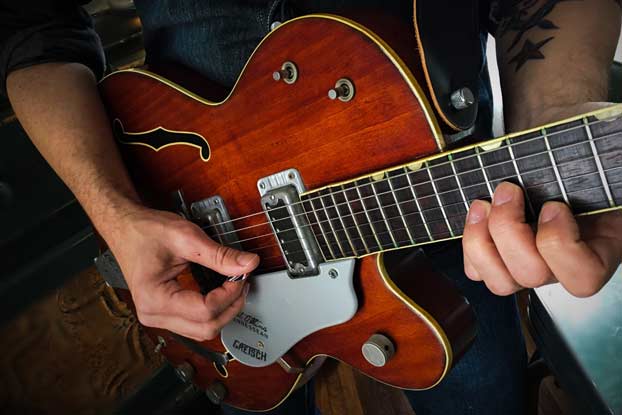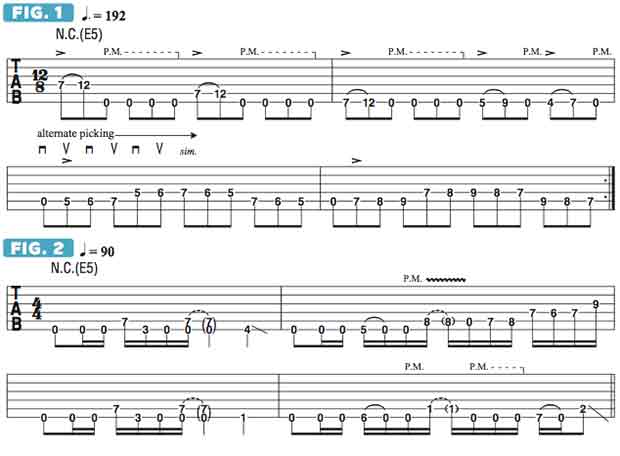Building Crushing Riffs from Complex Single-Note Patterns
Learn how to construct interesting, heavy and deceptively complex single-note riffs in this lesson.

As much as I love guitar parts built from fast and hyper-syncopated power-chord figures, some of the heaviest riffs I’ve ever heard are built from single-note patterns alone.
Legendary metal bands such as Metallica and Megadeth, as well as relatively newer groups like Children of Bodom, At the Gates and In Flames, have used crushing single-note riffs as the centerpieces of their most powerful songs.
In this column, I’d like to focus on how to construct interesting, heavy and deceptively complex single-note riffs. One of the coolest things about “modern” metal is that the idea of adhering to a central key or tonality is less important than the pursuit of aggressive, jarring sounds.
The resulting riffs often borrow from a variety of different scales and tonalities, which in turn leaves the possibilities wide open in terms of the moods and impressions these riffs can create.
FIGURE 1 is played in a 12/8 feel, which means there are three evenly spaced eighth-note pulses per beat—one-trip-let, two-trip-let, three-trip-let, four-trip-let. The overall tonality alluded to is E5, with a lean toward E minor, even though the major third of E, G#, appears in the riff.
Across bars 1 and 2, I repeatedly use wide-stretch hammer-ons as the signature elements that push the riff along. On beat one of bar 1, I hammer on from the D string’s seventh fret to the 12th fret with my index finger and pinkie before switching to a palm-muted open low E string pedal tone on beat two. On beat three, I move this index-pinkie hammer-on move over to the A string, and on beat one of bar 2 I move it down once more to the low E string.
On beat three of bar 2, that five-fret stretch is shortened to four frets, and on beat four it’s shortened to a three-fret stretch. Sometimes when playing these last two figures, I will follow the hammer-on with an additional pull-off to the open low E string before picking the palm-muted low E pedal.
Regarding the pick hand, I use downstrokes on all of the downbeats, followed by alternate (down-up) picking. Bars 3 and 4 are articulated with steady alternate picking, beginning with a downstroke, for which I play an “undefined” chromatic pattern, first in fifth position, and then moved up to seventh position. Use a metronome when practicing this riff and strive for clarity and precision, gradually increasing the tempo as your technique gets sharper.
FIGURE 2 is based on a 16th-note rhythm at a slower tempo. It has more of a “grinding” feel and is articulated primarily with alternate picking. Throughout this riff, I accentuate the 16th-note upbeats, such as the last 16th note of beat two in every bar, so the alternate-picking pattern changes to accommodate the syncopation of the line. Just keep the steady “down-up-down-up” approach in mind throughout the entire riff and you should have no problem executing it with power and authority.
In bars 1 and 3, I play a figure centered around low and high E notes on the sixth and fifth strings. In bar 1, I end the phrase with a slide down from the major third, G#. In bar 3, I switch to F, the b2 (flat two, or flatted second). The scale most commonly associated with the incorporation of both the major third and the b2 is Phrygian-dominant, which is the fifth mode of harmonic minor (made very popular by Yngwie Malmsteen). This riff is played in the key of E, so E Phrygian-dominant is E F G# A B C D.
Intervallically, the scale is spelled 1 b2 3 4 5 b6 b7. On beats three and four of bar 2, I switch to a single-note line articulated with straight alternate picking, and in bar 4 I juxtapose the b5 (flat five, or flatted fifth), Bb, against the natural, or perfect, fifth, B, which is played initially on the sixth string, then on the fifth. Now that you get the idea, create some of your own harmonically twisted riffs using these two different approaches as inspiration.
The possibilities are vast and endless, and this approach offers a great way to expand your musical palette as a guitarist and composer.

Get The Pick Newsletter
All the latest guitar news, interviews, lessons, reviews, deals and more, direct to your inbox!







![Joe Bonamassa [left] wears a deep blue suit and polka-dotted shirt and plays his green refin Strat; the late Irish blues legend Rory Gallagher [right] screams and inflicts some punishment on his heavily worn number one Stratocaster.](https://cdn.mos.cms.futurecdn.net/cw28h7UBcTVfTLs7p7eiLe.jpg)


